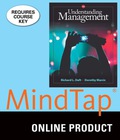
To determine:
If developing a comprehensive plan is not necessary to acquire a start-up funding.
Introduction:
Planning is a process of making the plan before executing any work. The process of planning includes identification of goals and objectives, formulation of strategies, creating the means required and implementation and monitoring.
The First step of planning is to establish a strategic goal. The strategic goal is a statement defining where the company wants to be in the future. The strategic goal represents the whole organization's goal rather than to the goal of a division or department. After setting the strategic goal, the organization prepares its strategic plans. Strategic plans define the action steps by which the company intends to attain strategic goals. Strategic plans are actually the blueprint that defines the organizational activities and allocations required for meeting long terms targets.
Want to see the full answer?
Check out a sample textbook solution
Chapter 5 Solutions
MINDTAP MANAGEMENT FOR DAFT/MARCIC'S UN
- 6 strategies to encourage a risk aware culture in the workplacearrow_forward3. Critically examine the importance of organisational culture in embedding risk management principles in a business. Suggest strategies to strengthen a risk-aware culture. (20 marks)arrow_forward1. Discuss how the application of PESTEL analysis can assist small businesses in identifying and managing external risks. Provide examples from at least three PESTEL categories. (20 marks)arrow_forward
- . Mention four early warning indicators that a business may be at risk.arrow_forward5. A risk that has both a high impact and high probability is referred to as A. Negligible B. Moderate C. Low D. Extreme 6. A business continuity plan is mainly used to_ A. Increase profits B. Handle daily tasks C. Prepare for disruptions D. Advertise services 7. What is the role of a risk owner? A. To finance the risk B. To monitor and manage a specific risk C. To create risks D. To avoid planning 8. Early warning indicators help businesses to A. Avoid legal actions B. Grow rapidly C. Detect potential risks D. Hire employees 9. A hazard-based risk includes A. Political instability B. Ergonomic issues C. Market demand D. Taxation changesarrow_forward1. What is the primary purpose of risk management in small businesses? A. To eliminate all risks B. To predict profits C. To reduce and control risks D. To create new risks 2. Which of the following is a type of operational risk? A. Interest rate change B. Natural disaster C. Supplier failure D. Tax policy change 3. SWOT analysis identifies all EXCEPT A. Strengths B. Weaknesses C. Tactics D. Opportunities 4. Which strategy involves taking no action against a risk? A. Mitigation B. Avoidance C. Acceptance D. Transferarrow_forward
- 5. A risk that has both a high impact and high probability is referred to as A. Negligible B. Moderate C. Low D. Extreme 6. A business continuity plan is mainly used to_ A. Increase profits B. Handle daily tasks C. Prepare for disruptions D. Advertise services 7. What is the role of a risk owner? A. To finance the risk B. To monitor and manage a specific risk C. To create risks D. To avoid planning 8. Early warning indicators help businesses to A. Avoid legal actions B. Grow rapidly C. Detect potential risks D. Hire employees 9. A hazard-based risk includes A. Political instability B. Ergonomic issues C. Market demand D. Taxation changesarrow_forward1. What is the primary purpose of risk management in small businesses? A. To eliminate all risks B. To predict profits C. To reduce and control risks D. To create new risks 2. Which of the following is a type of operational risk? A. Interest rate change B. Natural disaster C. Supplier failure D. Tax policy change 3. SWOT analysis identifies all EXCEPT A. Strengths B. Weaknesses C. Tactics D. Opportunities 4. Which strategy involves taking no action against a risk? A. Mitigation B. Avoidance C. Acceptance D. Transferarrow_forwardList and briefly describe four risk response strategies.arrow_forward
- Explain the purpose of a risk register.arrow_forwardAssume that your business is going to apply for a bank loan. Step into the shoes of a banking official who has the power to say yes or no to your loan application. From the bank’s vantage point, what are the strengths and weaknesses of your business plan? Does your plan seem realistic, given the financial assumptions and the business environment? What questions would you, as a bank officer, ask about your business plan? As the entrepreneur behind the business plan, how would you answer these questions and persuade the bank to approve your loan? Write up your questions and answers in one paragraph. Then use what you’ve learned to further strengthen your plan.arrow_forwardAssume that your business is going to apply for a bank loan. Step into the shoes of a banking official who has the power to say yes or no to your loan application. From the bank’s vantage point, what are the strengths and weaknesses of your business plan? Does your plan seem realistic, given the financial assumptions and the business environment? What questions would you, as a bank officer, ask about your business plan? As the entrepreneur behind the business plan, how would you answer these questions and persuade the bank to approve your loan? Write up your questions and answers in one paragraph. Then use what you’ve learned to further strengthen your plan.arrow_forward
 Foundations of Business (MindTap Course List)MarketingISBN:9781337386920Author:William M. Pride, Robert J. Hughes, Jack R. KapoorPublisher:Cengage Learning
Foundations of Business (MindTap Course List)MarketingISBN:9781337386920Author:William M. Pride, Robert J. Hughes, Jack R. KapoorPublisher:Cengage Learning Understanding Management (MindTap Course List)ManagementISBN:9781305502215Author:Richard L. Daft, Dorothy MarcicPublisher:Cengage Learning
Understanding Management (MindTap Course List)ManagementISBN:9781305502215Author:Richard L. Daft, Dorothy MarcicPublisher:Cengage Learning Management, Loose-Leaf VersionManagementISBN:9781305969308Author:Richard L. DaftPublisher:South-Western College PubMarketingMarketingISBN:9780357033791Author:Pride, William MPublisher:South Western Educational Publishing
Management, Loose-Leaf VersionManagementISBN:9781305969308Author:Richard L. DaftPublisher:South-Western College PubMarketingMarketingISBN:9780357033791Author:Pride, William MPublisher:South Western Educational Publishing Foundations of Business - Standalone book (MindTa...MarketingISBN:9781285193946Author:William M. Pride, Robert J. Hughes, Jack R. KapoorPublisher:Cengage Learning
Foundations of Business - Standalone book (MindTa...MarketingISBN:9781285193946Author:William M. Pride, Robert J. Hughes, Jack R. KapoorPublisher:Cengage Learning





